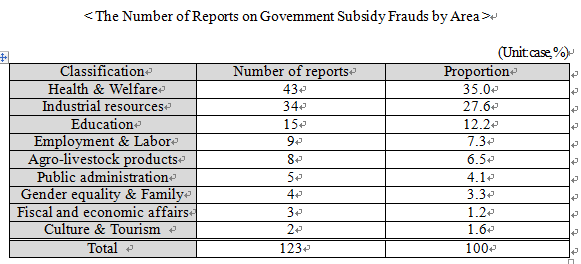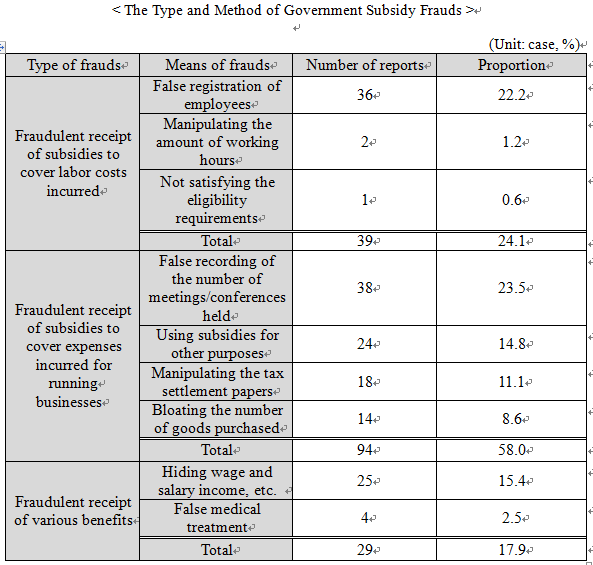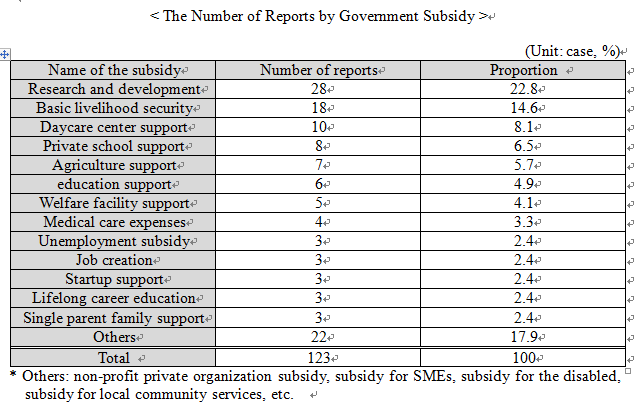The ACRC released the result of operation of the intensive reporting period for government subsidy
- Date2018-01-25
- Hit1,608
The ACRC released the result of operation of the intensive reporting period for government subsidy frauds and private school corruption
On December 28, 2017, the Anti-Corruption and Civil Rights Commission (ACRC, Chairperson Pak Un Jong) announced the result of operation of the intensive reporting period for government subsidy frauds and private school corruption for three months from September to November, 2017.
For the cited period, a total of 123 cases of reports on improper receipt of government subsidies and corruption have been received, and by area in which such corruption occurred, the number of cases reported in the top five areas, including health & welfare sector and industrial resources sector, accounted for 88.6% out of the total number of cases reported.

By type of subsidy fraud, taking the largest proportion with 94 cases reported (58.0%), fraudulent receipt of subsidies granted by the government to businesses to cover a part of the operating costs incurred was the most frequent, followed by the receipt of a subsidy to cover personnel expenses incurred with 39 cases reported (24.1%) and a fraud to cover the payroll of various kinds incurred with 29 cases reported (17.9%), etc.
By means of fraud, fraudulently drawing up actual records of conferences/meetings held or manipulating the roll book to record the attendance of trainees was the most frequently used means of fraud with 38 cases reported (23.5%), followed by falsely registering employees who actually do not work at a company in the list of employees of the company with 36 cases reported (22.2%).
On top of these, various cases of subsidy fraud have been identified, which includes: 25 cases (15.4%) of a fraud that involves hiding the wage and salary income or personal income from property, etc. whose amount is higher than that of such income eligible for the receipt of various benefits; 24 cases (14.8%) of a fraud through using a subsidy for purposes other than the original purpose for which the subsidy was granted; 18 cases (11.11%) of a fraud committed in a way of manipulating tax settlement s, such as issuing a false tax invoice, etc.; and 14 cases (8.6%) of a fraud to bloat the amount of costs incurred upon purchasing necessary articles or the amount of construction costs, etc.

By government subsidy, the research and development (R&D) subsidy was found to be the most fraud-prone with 28 cases reported (22.8%), followed by the basic livelihood security subsidy with 18 cases reported (14.6%), daycare center subsidy with 10 cases reported (8.1%), private school subsidy with 8 cases reported (6.5%), agriculture support subsidy with 7 cases reported (5.7%), education support subsidy with 6 cases reported (4.9%), welfare facility subsidy with 5 cases reported (4.1%), subsidy for medical care expenses with 4 cases reported (3.3%), unemployment subsidy, job creation support subsidy, startup subsidy, lifelong career education subsidy, single parent family subsidy with 3 cases reported for each of them (2.4%).

The ACRC has been receiving reports not only on welfare subsidy frauds and other various types of government subsidy frauds but also on subsidy frauds committed by private schools, public institutions and public officials at all times, and after confirming the fact of relevant frauds, it transfers the reported fraud cases to investigative agencies such as the prosecution, the police, and the board of audit and inspection, etc. and provides compensations of up to KRW 3 billion or prize money of up to KRW 200 million based on the amount of revenues recovered to the national treasury through reports on subsidy frauds.









